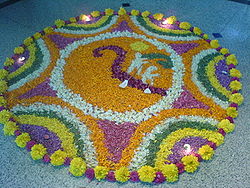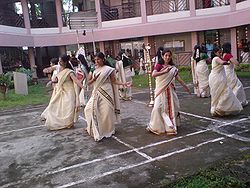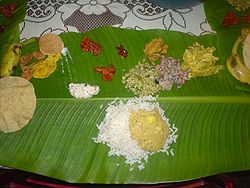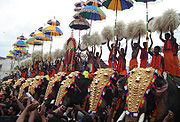Onam is the state festival of Kerala. It is celebrated in honour of Mahabali, the mythical Asura king of ancient Kerala. Malayalees believe that on Onam day Bali visits his subjects. This harvest festival falls in August / September. Onam has been part of Malayalee psyche for centuries. There are records of Onam being celebrated during the Sangam Age. The earliest record of the festival is found during the reign of Kulasekhara Perumals around AD 800. Onam has been part of Malayalee psyche for centuries. There are records of Onam being celebrated during the Sangam Age. The earliest record of the festival is found during the reign of Kulasekhara Perumals around AD 800.
Onam has two specific significances. First it is the memory of community at large and celebration of past history as enunciated in the Mahabali legend – a story of how paradise was lost. Second it is the celebration of the harvest, tied with the memory of the golden age of prosperity. It is believed that during those days the whole of Chingam was celebrated as Onam season. After the rain-drenched month of Karkidakam, with its privations, Chingam is a welcome month for people in the state of Kerala. The festival is the harbinger of spring — signalling the start of the harvest season. Onam epitomises the newfound vigour and enthusiasm of the season, and is celebrated with traditional fervour with visits to temples, family get-togethers, gifting of clothes called Onakkodi and lots of merrymaking. The Keralites perform the Mohiniattam Dance, dedicated to the female form of Vishnu Mohini. There is also the Krishnanaattam dance. Many Keralites also worship Narayani. Sri Narayani Peedam and Sri Bangaru Adigalar of Kerala and their followers claim that these two figures are a forms or avatars of the goddess Sri Narayani. Thiruvathira kali is another dance form performed at the time of onam.Onam is celebrated with flower,and sadhya(Kerala food).The flowers are decorated on the floor to welcome Mahabili There is also the Krishnanaattam dance. Many Keralites also worship Narayani. Sri Narayani Peedam and Sri Bangaru Adigalar of Kerala and their followers claim that these two figures are a forms or avatars of the goddess Sri Narayani. Thiruvathira kali is another dance form performed at the time of onam.Onam is celebrated with flower,and sadhya(Kerala food).The flowers are decorated on the floor to welcome Mahabili
The most important things about Onam are the onakkodi, the new clothes worn on this day and onam sadya, a feast which is quite elaborate. This is usually a feast served on banana leaves and serves rice along with at least an array of 4 dishes. Traditional pickles and papadam are also served. Dessert is usually 'payasam', a sweet dish made of milk, sugar and other traditional Indian savories. During Onam, people create a multi-coloured floral decoration on the ground in the front of their home called pookkalam. Young children especially girls are often entrusted with the task of gathering and laying out the flowers in elaborate patterns. Competitions are held on onam day to create this floral design. It is usually 1.5 m in Diameter usually in circular shape. A lamp is usually placed as part of the design. In the recent years, the floral designs have evoloved from the traditional circular shape to unique designs depicting different cultural and social aspects of Kerala life.
The Vallamkali (the snake boat race) is another event that is synonymous with Onam. Well-known races include the Aranmula Boat Race and the Nehru Trophy Boat Race. About 100 oarsmen row huge and graceful snake boats and men and women come from far and near to watch the snake boats skim through the water. During the Onam, Keralite Hindus install an image of Thrikkakara Appan (Vishnu in the form of Vamana) in their home just as Hindus install images or murtis of Lord Ganesh on the Ganesh Chaturi festival. This festival is also important because of its popularity with all communities within Kerala. Although the festival of Onam originated with, and is connected to the Hindu religion, it is celebrated today with equal fervour by the Hindus, Muslims and Christians of Kerala. Many lamps are lit in Hindu temples of Kerala during this celebration. A palmyra tree is erected in front of temples and surrounded with a wooden balustrade and covered with dry palmyra leaves. It is lit with a torch and burned to ashes to signify that Mahabali went to hell as a sacrifice. During the Onam, Keralite Hindus install an image of Thrikkakara Appan (Vishnu in the form of Vamana) in their home just as Hindus install images or murtis of Lord Ganesh on the Ganesh Chaturi festival. This festival is also important because of its popularity with all communities within Kerala. Although the festival of Onam originated with, and is connected to the Hindu religion, it is celebrated today with equal fervour by the Hindus, Muslims and Christians of Kerala. Many lamps are lit in Hindu temples of Kerala during this celebration. A palmyra tree is erected in front of temples and surrounded with a wooden balustrade and covered with dry palmyra leaves. It is lit with a torch and burned to ashes to signify that Mahabali went to hell as a sacrifice.
|
 Onam has been part of Malayalee psyche for centuries. There are records of Onam being celebrated during the Sangam Age. The earliest record of the festival is found during the reign of Kulasekhara Perumals around AD 800.
Onam has been part of Malayalee psyche for centuries. There are records of Onam being celebrated during the Sangam Age. The earliest record of the festival is found during the reign of Kulasekhara Perumals around AD 800.  There is also the Krishnanaattam dance. Many Keralites also worship Narayani. Sri Narayani Peedam and Sri Bangaru Adigalar of Kerala and their followers claim that these two figures are a forms or avatars of the goddess Sri Narayani. Thiruvathira kali is another dance form performed at the time of onam.Onam is celebrated with flower,and sadhya(Kerala food).The flowers are decorated on the floor to welcome Mahabili
There is also the Krishnanaattam dance. Many Keralites also worship Narayani. Sri Narayani Peedam and Sri Bangaru Adigalar of Kerala and their followers claim that these two figures are a forms or avatars of the goddess Sri Narayani. Thiruvathira kali is another dance form performed at the time of onam.Onam is celebrated with flower,and sadhya(Kerala food).The flowers are decorated on the floor to welcome Mahabili During the Onam, Keralite Hindus install an image of Thrikkakara Appan (Vishnu in the form of Vamana) in their home just as Hindus install images or murtis of Lord Ganesh on the Ganesh Chaturi festival. This festival is also important because of its popularity with all communities within Kerala. Although the festival of Onam originated with, and is connected to the Hindu religion, it is celebrated today with equal fervour by the Hindus, Muslims and Christians of Kerala. Many lamps are lit in Hindu temples of Kerala during this celebration. A palmyra tree is erected in front of temples and surrounded with a wooden balustrade and covered with dry palmyra leaves. It is lit with a torch and burned to ashes to signify that Mahabali went to hell as a sacrifice.
During the Onam, Keralite Hindus install an image of Thrikkakara Appan (Vishnu in the form of Vamana) in their home just as Hindus install images or murtis of Lord Ganesh on the Ganesh Chaturi festival. This festival is also important because of its popularity with all communities within Kerala. Although the festival of Onam originated with, and is connected to the Hindu religion, it is celebrated today with equal fervour by the Hindus, Muslims and Christians of Kerala. Many lamps are lit in Hindu temples of Kerala during this celebration. A palmyra tree is erected in front of temples and surrounded with a wooden balustrade and covered with dry palmyra leaves. It is lit with a torch and burned to ashes to signify that Mahabali went to hell as a sacrifice.

